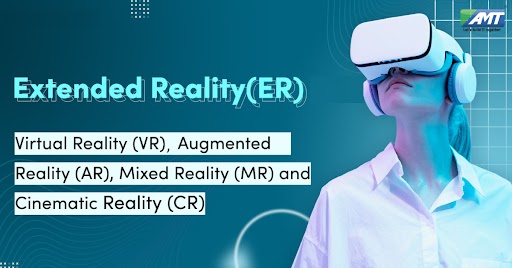Extended Reality (XR) is an umbrella term that encompasses various technologies and experiences that combine the physical world with digital elements. It is a continuum that includes Virtual Reality (VR), Augmented Reality (AR), and Mixed Reality (MR), each offering different levels of immersion and interaction:
- Virtual Reality (VR): VR is the most immersive form of XR. It involves creating a fully immersive digital environment that users can enter and interact with using specialized VR headsets. In VR, the physical world is entirely replaced by a computer-generated one, providing a highly immersive experience.
- Augmented Reality (AR): AR overlays digital content onto the real-world environment. It enhances the user’s perception of reality by adding computer-generated elements such as 3D objects, text, or images to the view of the real world. AR is often experienced through smartphones, tablets, smart glasses, or headsets.
- Mixed Reality (MR): Mixed Reality combines elements of both VR and AR. It allows digital objects to interact with and appear to be part of the real world. MR systems can understand the physical environment and respond to it, making it possible for users to interact with both real and virtual objects simultaneously.
Extended Reality applications are vast and span various industries, including:
- Entertainment: XR is used in gaming, immersive storytelling, and virtual tours.
- Education: XR technologies can create interactive learning experiences, from virtual field trips to anatomy simulations.
- Healthcare: Surgeons use AR to assist in complex surgeries, and VR is used for pain management and physical therapy.
- Training and Simulation: XR is valuable for training in fields like aviation, military, and industrial maintenance, providing realistic, risk-free environments.
- Architecture and Design: Architects and designers use XR to visualize and present their projects in 3D.
- Retail: AR apps can provide customers with interactive product experiences, virtual try-ons, and location-based promotions.
- Manufacturing: XR is used for product design, prototyping, and assembly line optimization.
- Tourism: AR and VR are used for virtual tourism experiences and wayfinding applications.
- Real Estate: XR can provide virtual property tours and interior design previews.
- Social Interaction: XR enables virtual meetings and social interactions in digital spaces.
The development and adoption of XR technologies continue to advance, driven by improvements in hardware, software, and the growing demand for immersive and interactive experiences across various sectors. As of my last knowledge update in September 2021, XR was already making significant strides, and it’s likely that there have been further advancements and innovations in the field since then.
Here are some additional key points and developments related to Extended Reality (XR) as of my last knowledge update in September 2021:
- Hardware Advancements: Hardware plays a crucial role in the development and adoption of XR. There were ongoing advancements in XR hardware, with companies like Oculus (now Meta Quest), HTC, Microsoft, and others releasing more powerful and affordable VR and AR headsets. The trend was toward standalone devices, reducing the need for tethering to powerful computers or consoles.
- Enterprise Adoption: XR was gaining traction in enterprise applications. Industries like manufacturing, healthcare, and aviation were using XR for training, maintenance, and remote assistance. It offered cost-effective and efficient ways to provide hands-on training and expert guidance.
- Content Creation: Content creation tools for XR were becoming more accessible. 3D modeling software, game engines like Unity and Unreal Engine, and AR/VR development platforms were widely available, enabling a growing community of content creators and developers.
- Immersive Learning: XR was increasingly being used in education for immersive learning experiences. Virtual classrooms, educational apps, and simulations were helping students engage with complex subjects in a more interactive and memorable way.
- Healthcare Innovations: In healthcare, XR was used not only for training but also for patient care. Surgeons were utilizing AR for navigation during surgeries, and VR was being used for pain management, physical therapy, and treating conditions like PTSD.
- Entertainment: The entertainment industry continued to experiment with XR. VR gaming was growing in popularity, and filmmakers were exploring VR and MR for creating more interactive and immersive cinematic experiences.
- Location-Based XR: Location-based XR experiences, such as VR arcades and AR-based city tours, were becoming more prevalent. These offered opportunities for social interaction and entertainment in physical spaces.
- Mixed Reality Glasses: Companies like Microsoft with the HoloLens and Magic Leap were working on mixed reality glasses that aimed to provide a seamless blend of the physical and digital worlds. These glasses had potential applications in various fields, including remote collaboration and industrial use cases.
- Standards and Development: XR was gradually maturing in terms of standards and development practices. Industry groups and organizations were working on standardizing aspects of XR, which was essential for interoperability and widespread adoption.
Please note that the XR landscape is highly dynamic, and developments in this field may have accelerated or evolved significantly since my last knowledge update in September 2021. It’s advisable to consult more recent sources and industry news to get the latest insights and trends in the world of Extended Reality.
Watch this space for more updates on the latest trends in Technology
